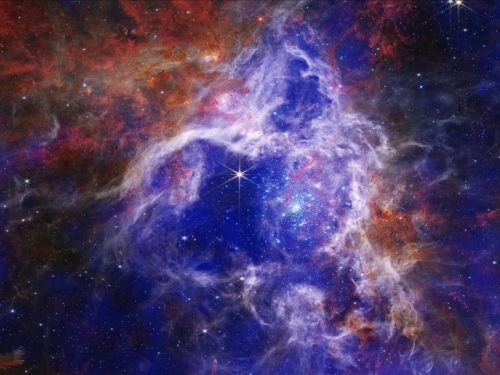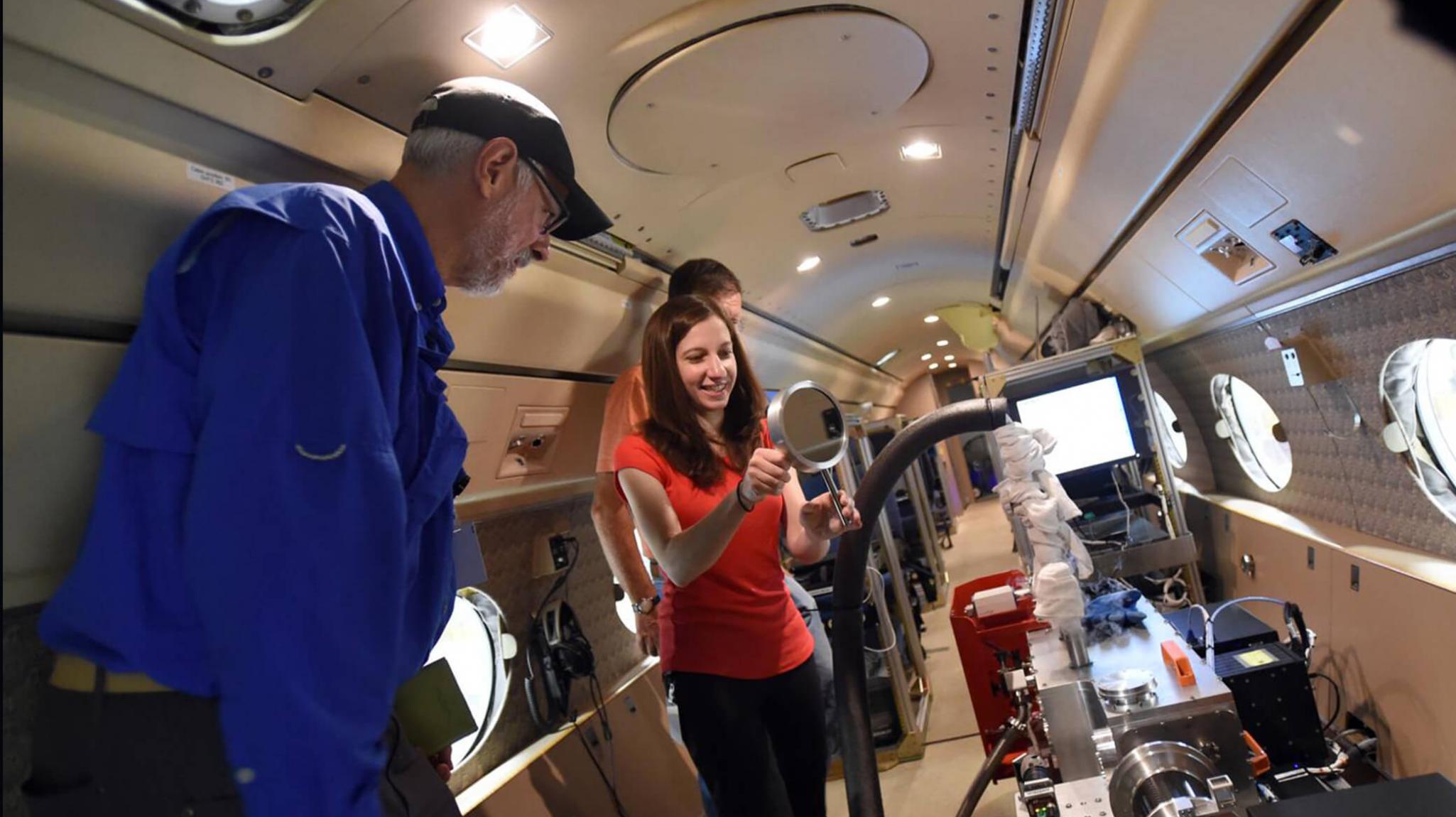
Mysteries of the Universe
Journey with us from our closest star to the far reaches of the universe.

The total solar eclipse on Aug. 21, 2017, as photographed from Madras, Oregon. The black circle in the middle is the Moon. Surrounding it are white streams of light belonging to the Sun’s outer atmosphere, called the corona. Image: NASA/Aubrey Gemignani
Did you know the Smithsonian is one of the world's foremost research centers? Launch into space with us and see what our scientists and researchers are discovering beyond our Earth.

On April 8, the moon will cross in front of the sun, blocking its light and casting a shadow over North America for a fleeting moment of awe. Nearly everyone in the United States will be able to witness the sun slowly dim or even disappear outside their windows, but a team of scientists led by Jenna Samra at the Center for Astrophysics | Harvard & Smithsonian (CfA) will be watching the solar eclipse from a different vantage point: from a plane flying in the sky.
Jenna studies the magnetic waves beaming from the sun’s outer atmosphere, called the “corona.” These waves produce “space weather,” or magnetic discharges that can affect the electronics on spacecraft, impact human health in space, and damage and disrupt electrical circuits on Earth. But the corona’s magnetic fields are hard to observe—scientists’ best chance of seeing them is when the corona is clearly visible, which only happens during a solar eclipse. In 2017, Jenna built an instrument designed to measure the properties and effects of these magnetic waves by detecting infrared light coming from the sun. She packed it aboard a jet and flew with it during that year’s eclipse. Her team cheered during totality—the moment when the sun completely disappeared behind the moon—when they could finally capture the data they spent months planning to collect. But scientists don’t rest on their achievements; this year, Jenna built a more advanced instrument and is performing the experiment again.
While Jenna will be spending the eclipse in the air, everyone else can join the National Air and Space Museum for its Solar Eclipse Festival on the National Mall.

Beyond the sun, Smithsonian scientists at the CfA are observing grand cosmic phenomena such as the birth and death of stars and black holes by using many different telescopes on the ground and in orbit around the Earth. One of those telescopes is celebrating its 25th anniversary this year: the Chandra X-ray Observatory, NASA’s flagship X-ray observatory, which the CfA helped develop and has been managing on NASA’s behalf since it launched aboard Space Shuttle Columbia in 1999. Chandra has the sharpest vision of any telescope that observes celestial objects using the X-ray band of the spectrum, which means it is effectively shining a light on unique and otherwise fleeting celestial activity and answering questions about the lifecycle of the universe that only it can answer. Plus, the CfA’s Chandra public engagement team has developed a multitude of resources to educate kids and get them engaged in the science of the cosmos.

Besides stars and galaxies, the Smithsonian also has its eyes on exoplanets, planets that orbit stars other than our sun. David Latham, an astronomer at CfA, discovered the first convincing evidence of an exoplanet in 1988 and, since then, more than 5,000 have been found. Twenty-two years after this initial discovery, CfA scientists found that not all exoplanets are bare rocks: in 2000, based on theoretical work by Harvard graduate student Sara Seager, CfA astronomer David Charbonneau and colleagues detected the atmosphere of an exoplanet for the first time. Skipping ahead another 22 years, CfA’s Mercedes Lopez-Morales and a team of about 100 scientists used the new capabilities of the James Webb Space Telescope to detect carbon dioxide in an exoplanet atmosphere for the first time, a possible signature of life. This was after CfA’s Rosanne Di Stefano and colleagues discovered the first-ever planet candidate in another galaxy, a Saturn-sized planet 28 million light years away. With all these exoplanet discoveries, will we ever prove that one of these exoplanets harbors life? Under a new initiative called AstroAI, a team of CfA computer scientists and astrophysicists led by Cecilia Garraffo is using artificial intelligence to mine previously unexamined stores of data from exoplanets to find signatures of life. The hunt is on.

A bit closer to home, scientists at the National Air and Space Museum’s Center for Earth and Planetary Studies are studying the history of our solar system. They’re characterizing the planets and their moons and searching for past life on a planet other than our own.
Scientist Tom Watters has characterized the physical geography of Mercury in great detail. Using data from NASA’s MESSENGER probe, he led a team that discovered Mercury’s “Great Valley” and found that the valley’s presence indicates the planet shrunk as it cooled a long time ago. Later, he discovered that Mercury has tectonic plates just like Earth and that it’s still shrinking! Watters and colleagues also discovered that our moon experienced recent geological activity, and is shrinking and tectonically active, just like Mercury. Before Watters, astronomers believed Earth was the only tectonically active body in the solar system.
Jumping over to Mars, we find the search for potentially habitable environments in the red planet’s history. In 2005, Ross Irwin, Bob Craddock, and colleagues found 21 ancient river channels on Mars, about the same width and depth of the rivers here on Earth, offering new clues about ancient Martian climate. The next year, Watters used a special type of radar called “sounding radar” to examine the subterranean geography of Mars for the first time, and he found ancient impact basins buried beneath the planet’s surface.
The National Air and Space Museum’s John Grant is also on the hunt for ancient habitable sites on Mars. When it came time to decide where to land the Perseverance rover, Grant co-led the community process for providing scientific input to the NASA team. With his help, NASA chose to place Perseverance in Jezero crater, which was once thought to be flooded with water, making it a possible breeding ground for life millions of years ago.
And finally, the Smithsonian has not forgotten about the outer planets. Our scholars are searching for signs of life on the moons of the gas giants—CfA’s own Matthew Holman and collaborators led a program that discovered the Neptunian moons. Emily Martin from the National Air and Space Museum is studying the moons of the gas giants. If you want to discover news, entertainment, and inspiration in the sky, check out the podcast Emily co-hosts called AirSpace.

As the largest astronomical research organization in the world, CfA looks outward to explore stars, solar systems, and galaxies light years away, but physicists like Kelly Chance also see outer space as a platform for studying our own planet, particularly our atmosphere. Launched in 2023, the space probe TEMPO is the first air pollution-monitoring satellite to sit in geostationary orbit over North America, meaning it stays centered on the continent, taking measurements of air pollution once per hour. The probe also offers higher resolution than any previous technique—it can detect hourly differences in air pollution from neighborhood to neighborhood. All told, this means TEMPO can detect harmful pollutants and track their movements throughout the day, helping us understand how best to reduce pollution and protect our health for the future.
Whether it’s the search for life on other planets or the search for answers on how our universe began, the Smithsonian’s astronomers, astrophysicists, and planetary geologists put life in perspective for us here on Earth. The pure vastness of space demonstrates how unique and fragile our planet is. Meanwhile, probes such as TEMPO, and its sister probe MethaneSat, both of which look down instead of up, use space to help us learn how best to conserve our planet and create a more sustainable future for all living beings who call this planet home.
CfA manages several space missions, such as the Chandra X-Ray Observatory and TEMPO, on NASA’s behalf and does all the science. For the types of telescopes only international consortia can build, such as the Giant Magellan Telescope, the CfA and the National Air and Space Museum contribute crucial instruments such as G-CLEF that allow these telescopes to succeed in exploring different pockets of the universe in new ways.
Space research leads to new inventions that could help us on Earth, plus it inspires people to continue their education and pursue careers in science, engineering, and education. And, if it leads us to find life on another planet, it could change the way we view our own origins and create a revolution in art, industry, and philosophy the world has never seen.
